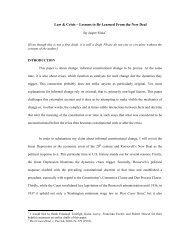updating brignoni-ponce - New York University School of Law
updating brignoni-ponce - New York University School of Law
updating brignoni-ponce - New York University School of Law
Create successful ePaper yourself
Turn your PDF publications into a flip-book with our unique Google optimized e-Paper software.
602 LEGISLATION AND PUBLIC POLICY [Vol. 11:567<br />
Alschuler argues, is enough to justify the resulting “ethnic tax.” 218 He<br />
reasons that the situation presented in Brignoni-Ponce was a justifiable<br />
use <strong>of</strong> race because supposedly 85% <strong>of</strong> undocumented immigrants<br />
were from Mexico. 219 He recognizes there is a trade<strong>of</strong>f between distributive<br />
justice and efficiency when race is considered, but he concludes<br />
that this is acceptable when an “agent’s focus on Latinos taxes<br />
the members <strong>of</strong> this group at a rate only slightly higher than their rate<br />
<strong>of</strong> <strong>of</strong>fending.” 220 However, he poses a hypothetical in which Latinos<br />
only constitute half <strong>of</strong> the undocumented immigrant population and<br />
concludes that, since this classification has limited power to exclude,<br />
concentrating enforcement on Latinos would be unjust. 221 Alschuler<br />
<strong>of</strong>fers little guidance <strong>of</strong> where the line can be drawn other than somewhere<br />
between 50% (not just) and 85% (just). 222 Under Alschuler’s<br />
logic, which considers the undocumented immigrant population on a<br />
national level, only Latino appearance can be used in immigration enforcement,<br />
since approximately 80% <strong>of</strong> undocumented immigrants are<br />
from Latin America. 223<br />
In essence, Alschuler is saying that the proportion <strong>of</strong> non-Latinos<br />
that are undocumented immigrants—20% 224 —is too small to justify<br />
expending immigration enforcement efforts on non-Latinos. This argument<br />
is particularly unfair to Latinos because the percentage <strong>of</strong> Latinos<br />
who are undocumented is similar to that <strong>of</strong> Asians and Middle<br />
Easterners. According to rough figures, about 10% <strong>of</strong> Latinos in the<br />
United States are undocumented immigrants. 225 Approximately 8% <strong>of</strong><br />
218. Alschuler, supra note 138, at 241. Although Alschuler never defines the term, R<br />
Randall Kennedy referred to the harms an innocent minority experiences in being<br />
stopped by law enforcement as a “tax” imposed on persons because <strong>of</strong> their ancestry.<br />
RANDALL KENNEDY, RACE, CRIME, AND THE LAW 159 (1997) [hereinafter KENNEDY,<br />
RACE]. Kevin Johnson criticized this term as smoothing “over the emotional turmoil,<br />
humiliation, and embarrassment caused by the actual experience <strong>of</strong> a race-based stop”<br />
and failing “to appreciate how race pr<strong>of</strong>iling undermines full and equal citizenship<br />
and stigmatizes Latino U.S. citizens and lawful immigrants in the United States.”<br />
Johnson, Against Racial Pr<strong>of</strong>iling in Immigration Enforcement, supra note 108, at R<br />
713; see also infra notes 276–277 and accompanying text. R<br />
219. Alschuler, supra note 138, at 239. R<br />
220. Id. at 241.<br />
221. Id. at 239–40.<br />
222. Id.<br />
223. UNDOCUMENTED IMMIGRANTS: FACTS AND FIGURES, supra note 107. R<br />
224. About 10% <strong>of</strong> undocumented immigrants are from Asia, 5% are from Canada<br />
and Europe, and 5% are from the rest <strong>of</strong> the world. UNDOCUMENTED IMMIGRANTS:<br />
FACTS AND FIGURES, supra note 107. R<br />
225. Johnson, Against Racial Pr<strong>of</strong>iling in Immigration Enforcement, supra note 108, R<br />
at 709.
















